Recently someone asked why I seed in flats when I could seed directly into peat pots or some other individual container, thus saving hours of transplanting. That’s a great question that deserves a thoughtful answer. The easiest answer is “That’s the way my mentor did it!” I learned greenhouse growing from a dear lady, Helen McFadden, who with her husband operated McFadden’s Greenhouses in Martinsville, IN. Up until then I’d just been growing things in styrofoam cups gleaned from all the area churches after their meetings, weddings, etc. But styrofoam cups (or any round pot for that matter) are not the most space-efficient way of growing…squares are. And generally, whether you grow as a hobby or as a business, space is the limiting factor, and getting the most return for that space is the goal.
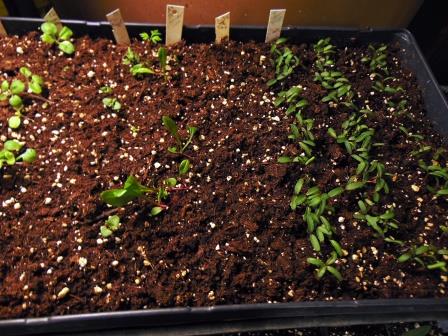 I seed most things in rows in seeding flats (a standard 10″ x 20″ undivided flat) because it saves space. Part of a recently seeded (March 6th) flat is shown. As you can see, not all varieties germinate at the same rate, but that’s fine. I can seed 150-200 onions in a 1″ x 10″ space, or the 200 marigolds shown at the right end of the flat in a 3″ x 10″ space. Plants can grow happily there until I can transplant them in individual pots or 4-packs. If something doesn’t germinate, or germinates poorly, it’s taking up very little space. It’s quicker to water a flat of seedlings than hundreds of pots. I do group them by who likes light, and who likes darkness, who needs warmth to germinate, etc. It’s easy to cover a seedling flat with a dome. If some varieties germinate quicker than others and the dome needs to come off, then I can cover the non-germinated rows with a bit of plastic wrap until they do. Plus I truly think they like growing close together in the beginning, rubbing shoulders with their neighbors, comforting one another. Call me crazy, I don’t care. I have happy plants.
I seed most things in rows in seeding flats (a standard 10″ x 20″ undivided flat) because it saves space. Part of a recently seeded (March 6th) flat is shown. As you can see, not all varieties germinate at the same rate, but that’s fine. I can seed 150-200 onions in a 1″ x 10″ space, or the 200 marigolds shown at the right end of the flat in a 3″ x 10″ space. Plants can grow happily there until I can transplant them in individual pots or 4-packs. If something doesn’t germinate, or germinates poorly, it’s taking up very little space. It’s quicker to water a flat of seedlings than hundreds of pots. I do group them by who likes light, and who likes darkness, who needs warmth to germinate, etc. It’s easy to cover a seedling flat with a dome. If some varieties germinate quicker than others and the dome needs to come off, then I can cover the non-germinated rows with a bit of plastic wrap until they do. Plus I truly think they like growing close together in the beginning, rubbing shoulders with their neighbors, comforting one another. Call me crazy, I don’t care. I have happy plants.
I HATE those little peat pots that begin as discs. Tried them a few times and NEVER did plants do as well as those done “my way.” It’s hard to keep them evenly moist so that seeds don’t dry out or get waterlogged. It’s hard to get the seed planted at the proper depth. It’s hard to add soil if for some reason a seedling does stretch. All that space taken with peat pots is space taken, and if something doesn’t germinate then what? Do you re-use that “contaminated” peat pot or just put it into compost? And in the meantime, all that space under lights or on a heating mat is being used inefficiently. In my experience seedlings don’t germinate as quickly in them. Never use them, never will.
Once a variety is ready to transplant, it’s easy to dislodge the larger, stronger seedlings and move them into individual pots. I use a pencil or a chopstick, stick it in at the side of a row all the way to the bottom of the flat and gently pry upward. If you are using a good potting soil or seed starting mix, they should come up easily. If it’s a cheap mix with lots of bark that the roots wrap around, then roots will be broken and plants will suffer a set-back. I only pry up an inch or two of the row at a time, and gently pull out the biggest, best seedlings. 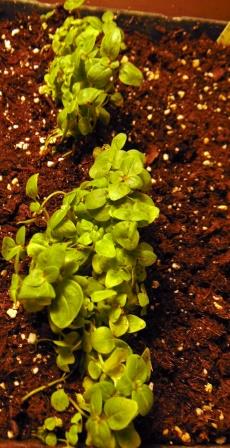 As an example, the row shown of “Liberty Bronze” snapdragons has already had 160 of the biggest, best seedlings gently removed and transplanted into fours. According to my records, last year I planted 156 of this variety into the gardens but noted that it was “not quite enough, do 1 more flat in 2019.” Considering that last year, many snapdragons returned and that this year it appears very few if any will survive the winter, I may eventually do an extra flat or two. If I don’t need them all, I can let the rest wait and grow some more, taking very little space during that time, and requiring very little care or area under lights. Sometimes if disaster strikes (a flat gets dropped, laid on by cat, or whatever) it’s nice to have those extra plants as back-up. And sometimes, especially with vegetable seedlings, I don’t need all of them ready at once but would rather transplant them in groups as space becomes available or when they are needed for succession plantings.
As an example, the row shown of “Liberty Bronze” snapdragons has already had 160 of the biggest, best seedlings gently removed and transplanted into fours. According to my records, last year I planted 156 of this variety into the gardens but noted that it was “not quite enough, do 1 more flat in 2019.” Considering that last year, many snapdragons returned and that this year it appears very few if any will survive the winter, I may eventually do an extra flat or two. If I don’t need them all, I can let the rest wait and grow some more, taking very little space during that time, and requiring very little care or area under lights. Sometimes if disaster strikes (a flat gets dropped, laid on by cat, or whatever) it’s nice to have those extra plants as back-up. And sometimes, especially with vegetable seedlings, I don’t need all of them ready at once but would rather transplant them in groups as space becomes available or when they are needed for succession plantings.
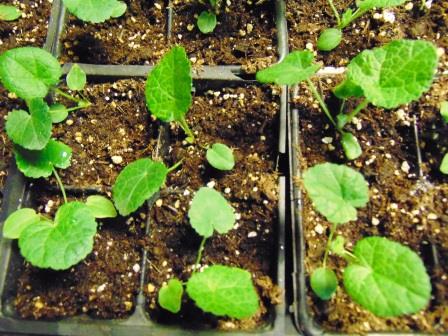 Generally seedlings go into 4-packs as shown, although some things may go into 3″ pots if they are fast growers, like dahlias. Things that dislike being transplanted, like parsley go into those deeper, larger pots, too. Depends on how much space I have (never enough!!!)
Generally seedlings go into 4-packs as shown, although some things may go into 3″ pots if they are fast growers, like dahlias. Things that dislike being transplanted, like parsley go into those deeper, larger pots, too. Depends on how much space I have (never enough!!!) 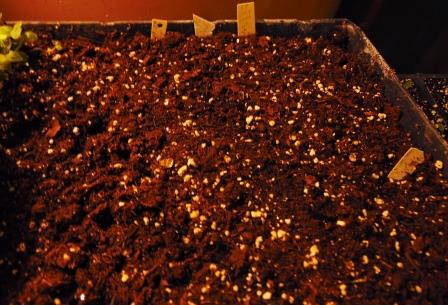 When all of a variety is transplanted, I can refill that space in the seeding flat with fresh potting soil and seed something new there, as long as I’m careful to match the seeds’ needs to the existing flat members. In the photo above, all of the violas that were first seeded in the same flat with the “Liberty Bronze” snaps (barely visible on the left) have been transplanted into 4’s, grown on a bit till the weather settled and are now in the greenhouse. That empty space in the flat was refilled with fresh potting soil and is now seeded with rows of leeks, calendula, and marigolds.
When all of a variety is transplanted, I can refill that space in the seeding flat with fresh potting soil and seed something new there, as long as I’m careful to match the seeds’ needs to the existing flat members. In the photo above, all of the violas that were first seeded in the same flat with the “Liberty Bronze” snaps (barely visible on the left) have been transplanted into 4’s, grown on a bit till the weather settled and are now in the greenhouse. That empty space in the flat was refilled with fresh potting soil and is now seeded with rows of leeks, calendula, and marigolds.
Actually, the main reason is that I love to transplant. It’s one of my favorite tasks, handling those little babies and tucking them into their new home. It gives me the opportunity to check their root systems, tuck them in a bit deeper than they were growing in the seeding flat and give them a word or two of encouragement. Every pot is a strong, healthy plant that I’ll need for the garden. No space is taken by a weak plant or “un-germinated” pot. I keep records, and when the number needed is reached, I stop transplanting that variety, at least for now, while space is at a premium. Later on, when the weather is settled and things can sit around idle outside, I may pot up some more, or set them directly into the gardens or containers or window boxes, or give them away.
Approximately 80% of the 4-packs go directly into the garden after hardening off. The other 20% get moved up into 3″ pots for growing on. These are generally things that take longer to grow and can’t go into the garden until the soil is really warm: tomatoes, peppers, eggplants, etc.
Large seeds that grow really quick (pumpkins, squashes, cucumbers, sunflowers, etc.) are seeded directly into 3″ pots at the start. They really don’t work well in the seeding flat system.
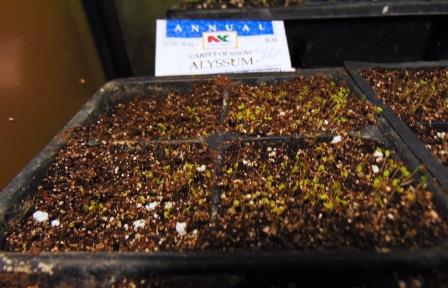 Some things are intentionally seeded thickly directly onto 4-packs, like sweet alyssum. Can you see the hint of pale green emerging? There are probably 50 seeds per little square. (I buy the end of season packs at 10 cents each, so I can seed generously.) They need light to germinate so the seeds are sprinkled thickly on top and given a pat to settle them into the moist soil surface, covered with a dome and set in a brightly lit spot. Once they germinate and are growing well, I can divide them into halves or quarters, depending upon how thickly they germinate, and plant those directly into the potager path edges, or tuck them into containers on the deck, or into the strawberry beds between blooming plants to attract pollinators. The original 32 cubes that only took up 10″ x 20″ of space becomes 128 “plugs” of almost instant fragrance and tiny blossoms. The fairies love it, and so do I! I often do lettuces and spinach the same way. Old seeds of questionable vigor are often treated this way as well, or those “mixed” wildflower or pollinator packages with seeds of various sizes and needs. Personally, I never purchase those, but if I get them free I won’t waste them and I’ve found that this method works quite well. (And in case you number people are wondering, “No,” I don’t bother to count all those sweet alyssum plants. Only the 32 original cubes are counted for the record totals.)
Some things are intentionally seeded thickly directly onto 4-packs, like sweet alyssum. Can you see the hint of pale green emerging? There are probably 50 seeds per little square. (I buy the end of season packs at 10 cents each, so I can seed generously.) They need light to germinate so the seeds are sprinkled thickly on top and given a pat to settle them into the moist soil surface, covered with a dome and set in a brightly lit spot. Once they germinate and are growing well, I can divide them into halves or quarters, depending upon how thickly they germinate, and plant those directly into the potager path edges, or tuck them into containers on the deck, or into the strawberry beds between blooming plants to attract pollinators. The original 32 cubes that only took up 10″ x 20″ of space becomes 128 “plugs” of almost instant fragrance and tiny blossoms. The fairies love it, and so do I! I often do lettuces and spinach the same way. Old seeds of questionable vigor are often treated this way as well, or those “mixed” wildflower or pollinator packages with seeds of various sizes and needs. Personally, I never purchase those, but if I get them free I won’t waste them and I’ve found that this method works quite well. (And in case you number people are wondering, “No,” I don’t bother to count all those sweet alyssum plants. Only the 32 original cubes are counted for the record totals.)
Dill, poppies, arugula, summer savory, cilantro seeds are sprinkled directly into 3″ pots because they need space for deep roots immediately and hate being transplanted. Once they are well grown, they can go into the ground as one mass, or divided into halves if all the seeds came up. (Here again, only the number of pots are counted, not the individual plants.)
So, that’s why I seed the way I do, and why I choose to transplant. It’s how I can grow the large number of plants (generally 4-5,000) I do in the small space I have now, but it is the method I used to grow for profit commercially for over forty years. It’s how I can afford to grow the variety of plants I crave for beauty and need to feed my family without spending a fortune on space, lights, heat and potting soil. Around here, a 32 flat of annuals sells for approximately $15, if you can even find them. Pretending that all my plants are “standard annuals” (which they are not) the cost would be $4743.75 plus tax! I don’t count my labor because it is my love, and I don’t know how much the 8 lights and one heating mat add to our winter electric bill, but seeds and potting soil generally hover around $4-500….cheaper than a gym membership or psychoanalysis! Hope this answers the question, but if not, please feel free to comment.

Those really are flat, not divided as I had imagined. I never thought of doing it that way but it makes sense.
By the way, Carolee, are you in the part of Indiana that suffered the late winter storm blast day before yesterday? One of my cousins wrote me about it, but she’s safe, on higher ground. Seems to quick a snow melt, plus rain storms, plus unstable water-logged soil, and high winds caused all the damage.
LikeLike
We had strong winds, but no damage. We are halfway between Indy and Fort Wayne, about 15 min. east of I69, if you can picture that. Most storms are either south of Indy or up closer to Lake Michigan, so we are generally pretty lucky…Knock wood!
LikeLiked by 2 people
That’s good!
LikeLike
Once again….so thankful I read your blog today! My alyssum is arriving soon, I was wondering what in the world I was going to do with 2,500 seeds!! I like your method of thickly seeding, I’ve never grown alyssum before, so I will give it a try! Thank you! I’ve been looking at the seed blocking that is so popular in Denmark….but like you, I’m doing what I was taught to do, this is what I know, and it works well, so this is what I do! And I’ve invested some money in the process, so we will see how it goes next year! BTW, I’ve finally officially looked up my growing zone, its 8a. Happy Planting!!
LikeLike
Wow, you are much further south than I thought. I’m in 5b officially according to the map, but in reality it’s 5a because we go colder than they list it. You should be much further along than we are, so I assume you have perennials up and growing, etc.
LikeLike
That’s the funny thing about those maps! I’m in Washington state, almost touching the Canadian border! The 8 loops up and around into our little NW Washington situation! The crocus is just now poking up, the daffodils have been poking along, in April the Skagit Valley Tulip festival will kick off with fields & fields of color!! But in my tiny micro-climate, the wind comes from the Canadian Frazer Valley, and our soil is still very damp! Even though it claims 8a, it’s not in the South!!
LikeLiked by 1 person
Interesting!
LikeLike
Alyssum I’ve only ever down straight into the soil and grown fine each time.
I do use lots of trays as limited on space. By the time they can be separated it will hopefully be warm enough outside for a lot to go out.
LikeLiked by 2 people
I’m not sure those maps help these days with the weather being so crazy.
I love your ideas and if I ever get my act together this make perfect since to do it this way.
LikeLiked by 2 people
Even before all that, those maps could be confusing, if not downright misleading. I think I’m in zone 6, maybe a 5, but who knows? I’m in South Central Washington state, and even in our county we have several micro-climates!
LikeLiked by 2 people
Well everything looks amazingly health. I have been charged with looking after some seed trays for a neighbour whilst on holiday ! Some responsibility! 🥀🥀🥀
LikeLike
Good luck! I’m having a plant sitter soon, and even though I trust her, it makes me nervous to be away!
LikeLike
Once again Carolee, your wealth of knowledge is so beneficial! My Grandfather could grown anything and I am privileged to remember him and his flowers well. But I was young enough not to know the value of his wealth of knowledge and experience. I’m so glad I inherited his genes and love of gardening, and it’s never to late to learn. Thank you again!
LikeLike
I learn something every season! It’s good to be a life-long learner!
LikeLike
Brilliant, very informative. If I wasn’t already doing as you do I’d start doing it! I actually use half trays rather than full size but for much the same reasons, just with a little added flexibility.
LikeLiked by 1 person
What a great idea. I’ve more flower seed sowing to do and I’ll follow your method.
LikeLiked by 1 person
I really enjoyed your post. I plant in everything I can get my hands on – flats, starter trays, solo cups, etc. I used to use peat pots, but avoid them now unless I find a good sale. Then, I rip off the top edge before planting so it doesn’t dry out and “lock” the roots inside. Great tips!
LikeLiked by 1 person
Yes, I learned to tear off the tops of those peat pots, too. I use them rarely, having switched to toilet paper rolls whenever possible, but sometimes I just don’t have enough of those. I soak the peat pots before filling with soil now, and that seems to help.
LikeLiked by 1 person
Yes, Carolee, soaking the peat pots first is a great idea, sort of like pre-soaking a new clay pottery pot before planting geraniums or ferns or ivy.
LikeLike
You nailed it Carolee. There is never enough space for starting seeds. I’ve gone the blockmaker route because I can get 8 2″ blocks in a Canadian 2 liter waxed milk container that I split in half to act as a tray. Transplanting with blocks isn’t as much fun though!
LikeLike
I haven’t done the 2″ soil blocks yet, but am finding the small ones useful for some crops and they certainly help with space…and no storage issues for all those plastic pots!!! I do enjoy transplanting as well, but I think there will always be some crops grown that will require it. Or, as my hands bother me more maybe transplanting won’t be as fun!
LikeLike